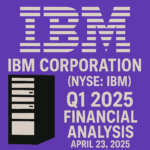Atlassian Corporation (TEAM) Stock Analysis
Atlassian Corporation (TEAM) Stock Analysis
Market Capitalization: $82.03 Billion
Shares Outstanding: 262.00 Million
Sector: Technology
Industry: Enterprise Software
Analysis as of: February 17, 2025
1. Company Overview
Atlassian Corporation (NASDAQ: TEAM) is a leading provider of collaboration and productivity software for teams across the globe. Founded to empower teams to work more efficiently, Atlassian offers a suite of products—including Jira, Confluence, and Trello—that streamline project management, communication, and software development. The company’s mission is to help teams unleash their full potential by fostering open, effective collaboration in today’s digital workplace.
Key Business Segments:
· Collaboration & Productivity Tools:
- Project Management & Issue Tracking: Flagship products like Jira facilitate agile software development and project management.
- Content & Knowledge Sharing: Confluence and other tools enable seamless documentation and information sharing among teams.
· DevOps & Software Development:
- Code Collaboration: Bitbucket and other integrations empower development teams to collaborate on code and streamline deployment.
- Automation & Integration: Atlassian’s platform connects with a broad ecosystem of third-party tools to enhance workflow automation.
Strategic Initiatives:
- Product Innovation: Continuous investment in R&D fuels enhancements across its suite of products, ensuring teams remain agile and competitive.
- Global Expansion: Strategic initiatives are underway to grow its international footprint and penetrate new markets.
- Customer-Centric Growth: By offering scalable solutions tailored to organizations of all sizes, Atlassian aims to deepen customer engagement and boost recurring revenues.
- Ecosystem Development: Expanding its partner network and integrations helps create a seamless workflow environment that drives long-term customer loyalty.
2. Financial Performance
a. Revenue and Growth
- TTM Revenue: $4.79 Billion
- YoY Revenue Growth: Approximately +23%
Analysis:
Atlassian continues to experience robust revenue growth, driven by strong demand for its enterprise collaboration solutions. With a year-over-year increase of around 23%, the company’s expanding customer base and increased product adoption underscore its success in a competitive market.
b. Profitability
- Net Income (TTM): -$346.14 Million
- EPS (TTM): -$1.33
- Forward PE: 81.75
Analysis:
Despite its impressive revenue growth, Atlassian currently reports a net loss, reflecting significant reinvestment in product development and global expansion. The forward PE of 81.75 suggests that investors remain optimistic about future profitability and expect the company to turn its investments into positive earnings over time.
c. Margins
- Gross Margin: 81.82%
- Operating Margin: -2.89%
- Profit Margin: -7.22%
Analysis:
The high gross margin indicates efficient management of direct costs, even as the company invests heavily in R&D and sales efforts. However, the negative operating and profit margins signal that ongoing expenses are currently outpacing earnings, a trade-off many growth companies accept while scaling their operations.
d. Cash Flow
- Operating Cash Flow (TTM): $1.42 Billion
- Capital Expenditures (TTM): -$39.06 Million
- Free Cash Flow (TTM): $1.38 Billion
- FCF Per Share: $5.29
Analysis:
Atlassian’s robust operating cash flow and healthy free cash flow generation demonstrate that the company is capable of funding its growth initiatives. Strong cash flow provides the flexibility needed for further investments in innovation and market expansion, even as the firm works to reverse its net losses.
3. Balance Sheet
- Cash & Equivalents: $2.47 Billion
- Total Debt: $1.24 Billion
- Net Cash Position: $1.22 Billion (approximately $4.67 per share)
- Book Value Per Share: $4.65
- Working Capital: $637.13 Million
- Debt/Equity Ratio: 1.02
Analysis:
Atlassian maintains a solid balance sheet with a net cash position that supports its strategic investments. Although its debt-to-equity ratio is slightly above 1, the company’s ample liquidity and working capital provide a stable foundation to sustain growth and manage short-term obligations.
4. Valuation
- PE Ratio: n/a
- Forward PE: 81.75
- PS Ratio: 17.00
- PB Ratio: 67.28
- P/FCF Ratio: 59.23
- P/OCF Ratio: 57.61
- PEG Ratio: 3.23
Analysis:
Atlassian trades at high valuation multiples, reflective of strong growth expectations despite its current losses. Elevated forward PE, PS, and PB ratios indicate that investors are pricing in significant future profitability. However, the high valuations also suggest a premium that will require continued revenue expansion and eventual earnings turnaround to justify.
5. Market Performance
- 52-Week Range: $135.29 – $326.00
- Last Close Price: $313.10
- 52-Week Price Change: +49.05%
- Beta (5Y): 0.87
- 50-Day Moving Average: $272.36
- 200-Day Moving Average: $203.25
- RSI: 65.32
- Average Volume (20 Days): 2,160,024
- Short Interest: 4.19 Million shares (2.56% of outstanding)
Analysis:
Atlassian’s stock has risen significantly over the past year, reflecting strong investor confidence. A beta of 0.87 indicates lower volatility relative to the broader market. The RSI, while elevated at 65.32, remains in a moderately overbought zone, suggesting healthy buying momentum without immediate risk of a reversal. Active trading volumes and low short interest further underscore the market’s positive sentiment.
6. Financial Health and Risks
Liquidity:
With a current ratio of 1.24 and a quick ratio of 1.18, Atlassian has adequate liquidity to meet its short-term obligations, though modest relative to some peers.
Leverage:
A debt-to-equity ratio of 1.02 and a debt/FCF ratio of 0.90 indicate that the company uses leverage to fund its operations. While this financing approach supports growth, it also requires careful management to ensure eventual profitability.
Profitability & Cash Flow:
Despite current losses, Atlassian’s strong gross margin and healthy free cash flow highlight its operational efficiency. The company’s reinvestment strategy is designed to drive future earnings growth, though the path to sustained profitability remains a key risk.
Operational Risks:
The competitive landscape in enterprise software is intense. Atlassian must continuously innovate and fend off rivals while managing rising operational costs during its growth phase.
Market & Regulatory Risks:
Shifts in technology trends, evolving customer demands, and potential regulatory changes in global markets could impact Atlassian’s performance. Moreover, its high valuation multiples add pressure for a swift turnaround in earnings.
7. Conclusion
Pros:
- Strong Revenue Growth: Consistent year-over-year revenue increases of approximately 23% underline robust market demand.
- Solid Cash Flow Generation: Operating cash flow of $1.42 billion and free cash flow of $1.38 billion provide the resources needed for growth investments.
- High Gross Margins: An 81.82% gross margin reflects efficient cost management on the core business.
- Attractive Market Performance: The stock’s 49.05% price appreciation over the past year, coupled with a low beta, indicates favorable market sentiment.
Cons:
- Current Losses: Negative net income and EPS illustrate the company’s heavy reinvestment phase, which may continue to pressure short-term profitability.
- High Valuation Multiples: Forward PE of 81.75 and elevated PS and PB ratios suggest a premium valuation that demands significant future growth.
- Leverage Concerns: A debt-to-equity ratio of 1.02 and high debt/EBITDA ratios signal reliance on debt financing, which could pose risks if earnings fail to improve.
- Competitive and Regulatory Pressures: The fast-evolving enterprise software market and potential regulatory shifts remain significant risks.
Final Note:
Atlassian Corporation continues to drive transformational change in how teams collaborate and manage work. With strong revenue growth and impressive free cash flow, the company is well-positioned to capitalize on its innovative product suite. However, its current losses and high valuation multiples underscore the challenges ahead as it strives to achieve sustained profitability. Investors should weigh these factors carefully when considering exposure to Atlassian.
Disclaimer:
This analysis is for informational purposes only and does not constitute investment advice. Investing involves risks, including potential loss of principal. Past performance is not indicative of future results. Please consult a qualified financial advisor before making any investment decisions.





